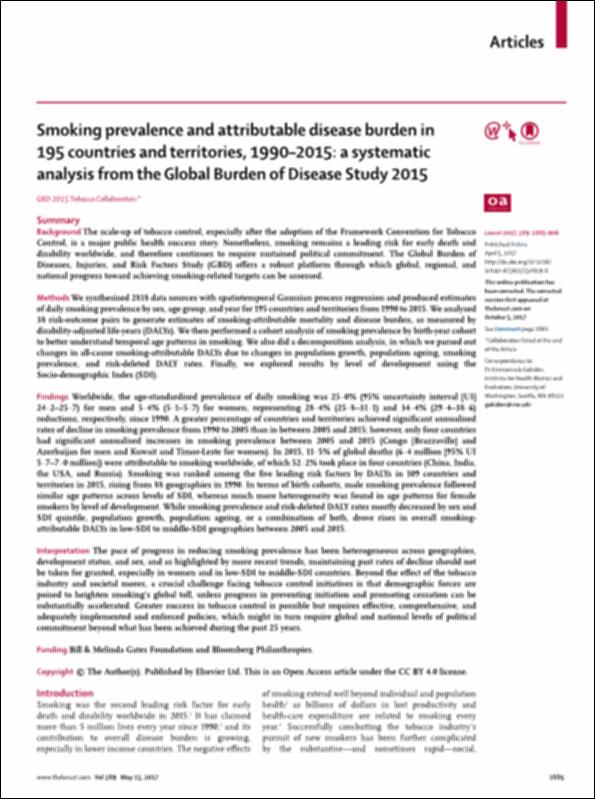Por favor, use este identificador para citar o enlazar este ítem:
http://hdl.handle.net/10637/13363Smoking prevalence and attributable disease burden in 195 countries and territories, 1990-2015 : a systematic analysis from the Global Burden of Disease Study 2015
| Título : | Smoking prevalence and attributable disease burden in 195 countries and territories, 1990-2015 : a systematic analysis from the Global Burden of Disease Study 2015 |
| Autor : | Reitsma, Marissa B. Martínez Raga, José GBD 2015 Tobacco Collaborators |
| Materias: | Tabaco - Consumo - Muerte.; Tabaco - Adicción - Muerte.; Tobacco consumption - Risk factors.; Tobacco abuse - Death.; Tabaco - Consumo - Factores de riesgo.; Tabaco - Adicción - Factores de riesgo.; Tobacco consumption - Death.; Tobacco abuse - Risk factors. |
| Editorial : | Elsevier |
| Citación : | GBD 2015 Tobacco Collaborators ; Reitsma, M.B. et al. (2017). Smoking prevalence and attributable disease burden in 195 countries and territories, 1990-2015 : a systematic analysis from the Global Burden of Disease Study 2015. The Lancet, vol. 389, i. 10082 (13 may), pp. 1885-1906. DOI: https://doi.org/10.1016/S0140-6736(17)30819-X |
| Resumen : | Background The scale-up of tobacco control, especially after the adoption of the Framework Convention for Tobacco Control, is a major public health success story. Nonetheless, smoking remains a leading risk for early death and disability worldwide, and therefore continues to require sustained political commitment. The Global Burden of Diseases, Injuries, and Risk Factors Study (GBD) offers a robust platform through which global, regional, and national progress toward achieving smoking-related targets can be assessed. Methods We synthesised 2818 data sources with spatiotemporal Gaussian process regression and produced estimates of daily smoking prevalence by sex, age group, and year for 195 countries and territories from 1990 to 2015. We analysed 38 risk-outcome pairs to generate estimates of smoking-attributable mortality and disease burden, as measured by disability-adjusted life-years (DALYs). We then performed a cohort analysis of smoking prevalence by birth-year cohort to better understand temporal age patterns in smoking. We also did a decomposition analysis, in which we parsed out changes in all-cause smoking-attributable DALYs due to changes in population growth, population ageing, smoking prevalence, and risk-deleted DALY rates. Finally, we explored results by level of development using the Socio-demographic Index (SDI). Findings Worldwide, the age-standardised prevalence of daily smoking was 25·0% (95% uncertainty interval [UI] 24·2–25·7) for men and 5·4% (5·1–5·7) for women, representing 28·4% (25·8–31·1) and 34·4% (29·4–38·6) reductions, respectively, since 1990. A greater percentage of countries and territories achieved significant annualised rates of decline in smoking prevalence from 1990 to 2005 than in between 2005 and 2015; however, only four countries had significant annualised increases in smoking prevalence between 2005 and 2015 (Congo [Brazzaville] and Azerbaijan for men and Kuwait and Timor-Leste for women). In 2015, 11·5% of global deaths (6·4 million [95% UI 5·7–7·0 million]) were attributable to smoking worldwide, of which 52·2% took place in four countries (China, India, the USA, and Russia). Smoking was ranked among the five leading risk factors by DALYs in 109 countries and territories in 2015, rising from 88 geographies in 1990. In terms of birth cohorts, male smoking prevalence followed similar age patterns across levels of SDI, whereas much more heterogeneity was found in age patterns for female smokers by level of development. While smoking prevalence and risk-deleted DALY rates mostly decreased by sex and SDI quintile, population growth, population ageing, or a combination of both, drove rises in overall smokingattributable DALYs in low-SDI to middle-SDI geographies between 2005 and 2015. Interpretation The pace of progress in reducing smoking prevalence has been heterogeneous across geographies, development status, and sex, and as highlighted by more recent trends, maintaining past rates of decline should not be taken for granted, especially in women and in low-SDI to middle-SDI countries. Beyond the effect of the tobacco industry and societal mores, a crucial challenge facing tobacco control initiatives is that demographic forces are poised to heighten smoking’s global toll, unless progress in preventing initiation and promoting cessation can be substantially accelerated. Greater success in tobacco control is possible but requires effective, comprehensive, and adequately implemented and enforced policies, which might in turn require global and national levels of political commitment beyond what has been achieved during the past 25 years. |
| Descripción : | Este artículo se encuentra disponible en la siguiente URL: https://www.sciencedirect.com/science/article/pii/S014067361730819X?via%3Dihub |
| URI : | http://hdl.handle.net/10637/13363 |
| Derechos: | http://creativecommons.org/licenses/by/4.0/deed.es |
| ISSN : | 0140-6736 1474-547X (Electrónico) |
| Fecha de publicación : | 13-may-2017 |
| Centro : | Universidad Cardenal Herrera-CEU |
| Aparece en las colecciones: | Dpto. Farmacia |
Los ítems de DSpace están protegidos por copyright, con todos los derechos reservados, a menos que se indique lo contrario.


